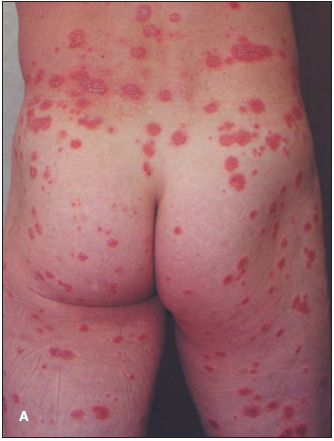 A 13-year-old boy presented with an explosive eruption of numerous, small, round, erythematous, itchy plaques on his lower back and lower limbs of 2 weeks' duration (A). Some of the lesions were scaly. His nails were normal. There was no evidence of arthritis or joint deformity. He had a sore throat a month before the onset of the rash but did not seek medical attention. He was not taking any medication and had no history of joint pain or family history of skin problems.
A 13-year-old boy presented with an explosive eruption of numerous, small, round, erythematous, itchy plaques on his lower back and lower limbs of 2 weeks' duration (A). Some of the lesions were scaly. His nails were normal. There was no evidence of arthritis or joint deformity. He had a sore throat a month before the onset of the rash but did not seek medical attention. He was not taking any medication and had no history of joint pain or family history of skin problems.
Alexander K. C. Leung, MD, and Wm. Lane M. Robson, MD, of Calgary, Alberta, diagnosed psoriasis. Childhood psoriasis is fairly common; it is diagnosed before the age of 10 years and 15 years in approximately 10% and 30% of cases, respectively.1,2 Estimates of prevalence range from 0.1% to 3%.3,4 The prevalence is greatest in northern, colder climates,4 and the disease is more severe in the colder winter months.5 Both sexes are affected equally.6
A family history of psoriasis in first-degree relatives is present in about 30% of patients with childhood-onset psoriasis.7 The concordance rate in monozygotic twins is approximately 72%, compared with 12% to 23% in dizygotic twins.8 An association exists between psoriasis and various histocompatibility antigens. The association is strongest for the HLA-Cw6 allele; the disease develops in approximately 10% of HLA-Cw6-positive patients.9 Psoriasis susceptibility loci within the major histocompatibility complexes have been mapped to several chromosomes.
 Streptococcal infection may lead to psoriasis via a mechanism that activates CD4+ T cells by a superantigen.7 Guttate psoriasis is associated with group A b-hemolytic streptococcal pharyngitis and perianal dermatitis10 and has been reported to occur after Kawasaki disease.11 Staphylococcal infection and HIV infection have also been reported as possible triggers of psoriasis.7
Streptococcal infection may lead to psoriasis via a mechanism that activates CD4+ T cells by a superantigen.7 Guttate psoriasis is associated with group A b-hemolytic streptococcal pharyngitis and perianal dermatitis10 and has been reported to occur after Kawasaki disease.11 Staphylococcal infection and HIV infection have also been reported as possible triggers of psoriasis.7
Predisposing factors include use of certain medications, withdrawal of corticosteroids in a susceptible person, emotional stress,1 alcohol( or tobacco consumption, trauma (Köbner phenomenon), hypocalcemia, xerosis, and sunburn.12
Plaque psoriasis, or psoriasis vulgaris, is the most common variant in both adults and children13,14; it is characterized by sharply demarcated erythematous plaques with adherent silvery, micaceous scales (B and C).1,15 Removal of the scales results in fine punctate bleeding, which is referred to as the Auspitz sign.4,13 Lesions are usually pruritic and symmetrically distributed. Typical sites include the knees, elbows, and lower back. Involvement of the scalp, face, intertriginous areas, and diaper area is more common in infants and children.4,7 Mucosal involvement is unusual.
 Other variants include guttate psoriasis, which is most common in children, adolescents, and young adults,16 and pustular psoriasis and erythrodermic psoriasis, which are rare in childhood.7,17
Other variants include guttate psoriasis, which is most common in children, adolescents, and young adults,16 and pustular psoriasis and erythrodermic psoriasis, which are rare in childhood.7,17
Nail involvement, such as pitting of the nail, onycholysis, and discoloration, is uncommon in children.6 Seronegative inflammatory arthritis develops in about 4% to 9% of children with psoriasis.18 Psoriatic arthritis may precede, coincide with, or follow the development of the skin lesions.1
Psoriasis is a clinical diagnosis. In patients with guttate psoriasis, consider culture from an appropriate site (throat, perianal area) and measurement of serum antistreptolysin O titers.17
Advise patients to avoid triggers and exacerbating factors when possible. Optimal skin care requires constant attention to hydration and lubrication and other efforts to minimize itching. Discourage scratching to minimize the Köbner phenomenon. Moisturizers and emollients help soften the scaly, hyperkeratotic surface of the affected area and are fundamental to successful treatment. Topical medications (corticosteroids; immunomodulators, such as tacrolimus( and pimecrolimus(; calcipotriene; and retinoids) are generally safe and remain the first-line treatment for most patients.
Consider phototherapy--alone or in combination with other topical remedies--in older children with refractory disease or whose lesions are too widespread for topical treatment.6,15 Side effects include sunburn, aging of the skin, and increased risk of skin cancer.13,19
Because of its associated toxicity, systemic treatment is usually reserved for severe and generalized forms of psoriasis that are resistant to other therapies.9,20 Combination systemic therapy (with methotrexate(, acitretin(, or cyclosporine) can achieve additive or synergistic efficacy and reduce the dosage and risk of adverse events.21
For this patient, application of moisturizer was recommended and an immunomodulator was prescribed.


